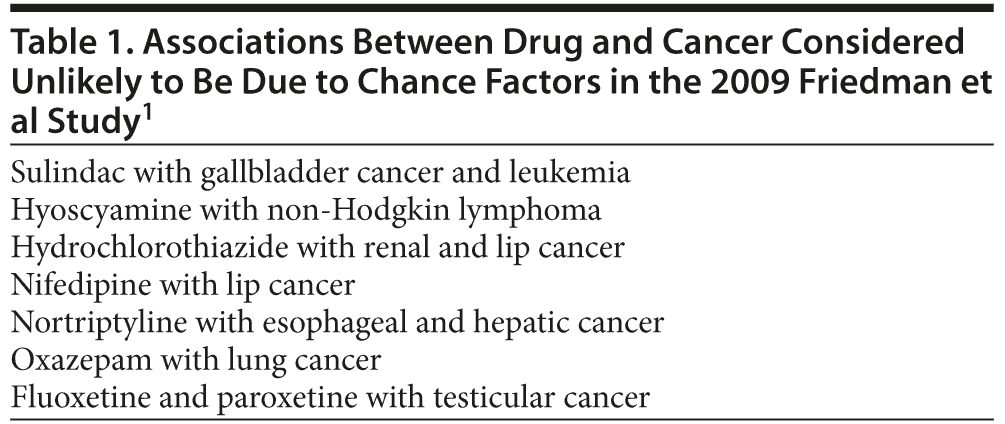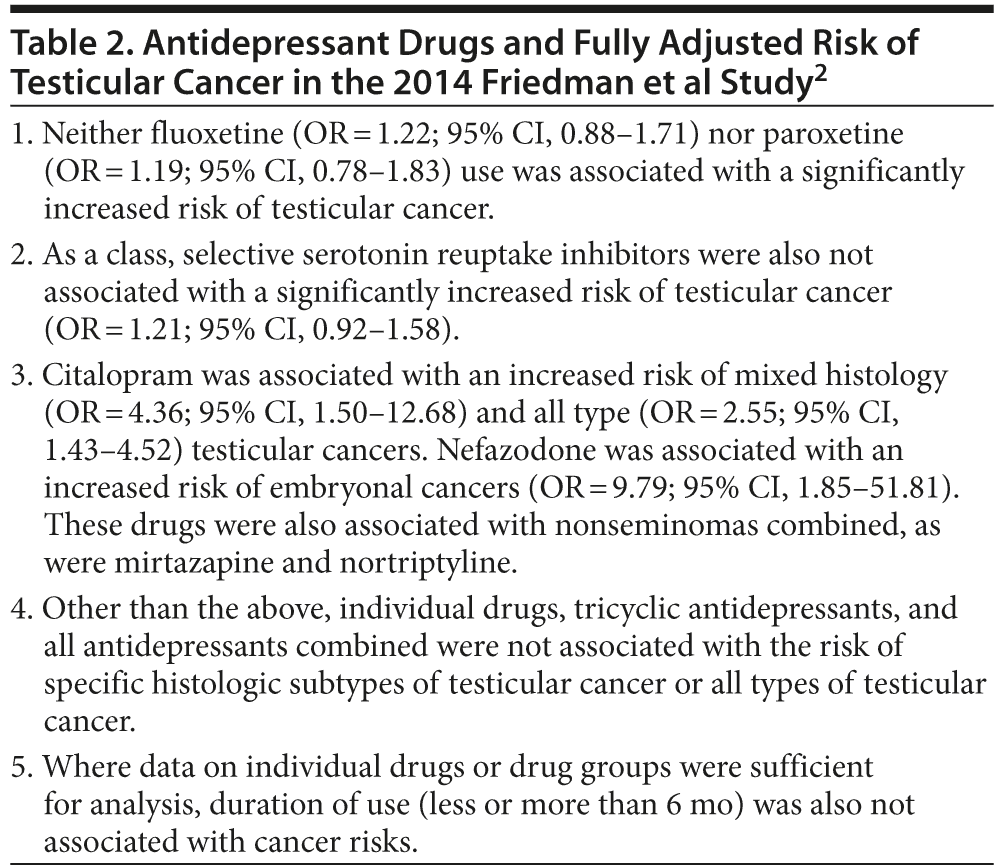
- The best quality clinical evidence is obtained from randomized controlled trials.
- Case-control and other study designs may provide useful leads but cannot confirm causality of association between drugs and adverse events.
- Confounding from suspected or unsuspected sources may explain spurious relationships between drugs and adverse events.
ABSTRACT
A data mining study that examined associations between 105 drugs and 55 cancer sites found significant associations between 2 selective serotonin reuptake inhibitors (fluoxetine and paroxetine) and testicular cancer. The study suggested several reasons why these associations merited further investigation. A later study tested specific relationships between 12 antidepressant drugs and testicular cancer and subtypes thereof; whereas significant relationships were again found, these disappeared after adjusting for confounding variables. These 2 studies are educative because they illustrate how false-positive results can easily arise in exploratory research and how confounding may be responsible for statistically significant relationships in study designs that are not randomized controlled trials.
J Clin Psychiatry 2014;75(3):e198-e200 (doi:10.4088/JCP.14f09056)
© Copyright 2014 Physicians Postgraduate Press, Inc.
Clinical Problem
Studies sometimes suggest an increased risk of an adverse event associated with the use of a drug or group of drugs. How should clinicians regard such findings?
Large, well-designed, and well-executed randomized controlled trials (RCTs) provide the best quality evidence about the effects of medications. For example, if RCTs show that an antipsychotic drug is associated with greater weight gain than placebo, it is very likely that the antipsychotic drug is causally responsible for the weight gain. Clinicians therefore have a clear idea of what to expect when the drug is prescribed.
Nonrandomized investigations, in contrast, might identify significant associations that are not necessarily causal in nature. For example, a nonrandomized study may show that congenital malformations are more common in the offspring of women who used antidepressants during pregnancy than in the offspring of women who did not. One interpretation of these results is that antidepressants increase the risk of congenital malformations. Another possibility is that the psychiatric illness (for which the antidepressants were prescribed) produced behavioral changes that increased the malformation risk. Still other explanations are possible, for example, that genetic factors predisposed to depression in the mother as well as to malformations in the offspring. Clinicians have no way of knowing which explanation is right and therefore need to keep in mind all possibilities during risk-benefit analyses prior to prescribing the drug.
This article examines antidepressant drugs and testicular cancer as a case in point, with an initial study in which significant associations were identified and a follow-up study in which the associations were re-tested. The 2 studies offer interesting learning points for the reader.
The First Study
Friedman et al1 examined the possible carcinogenic effects of 105 common drugs by using data drawn from a 6.6 million-member prescription database. Each drug had been received by at least 25,000 patients. Each drug was tested for association with 55 cancer sites in a 1:10 matched case-control design. In these analyses, follow-up data were available for up to 12.5 years.
The authors described several efforts to rule out chance findings and biases due to confounding. For example, they required that the drug should increase the cancer risk by at least 50%, that the P value for significance should be < .01, that these results should be obtained for use of drug antedating the cancer by at least 2 years, that there should be a significant dose-dependent risk, and so on. Attempts were also made to include potential confounding variables (eg, HIV infection, use of sex hormones) in analyses, as relevant and to the extent that data were available.
Of all the drug-cancer associations tested, 101 were found to be of interest in relation to 61 drugs. Of these, 66 were considered to be involved with substantial confounding. Out of the remaining 35, only about a dozen were considered unlikely to represent chance associations (Table 1).
Of specific interest was the association between 2 selective serotonin reuptake inhibitors (SSRIs; fluoxetine and paroxetine) and testicular cancer. The fluoxetine finding (relative risk [RR] = 2.56; 95% CI, 1.39-4.53) was based on 14 cases of testicular cancer in patients who used the drug for a median of 10 months. The paroxetine finding (RR = 2.44; 95% CI, 1.25-4.74) was based on 11 cases with a median duration of use of 10 months. There was an overlap between fluoxetine and paroxetine in 3 of the cases of testicular cancer. The authors1 considered these findings biologically plausible because, in high doses, both fluoxetine and paroxetine have been associated with testicular damage in rats.
The Second Study
Friedman et al2 reexamined the specific possibility of an association between antidepressant use and testicular cancer using data from the same source as the earlier study,1 with 4 additional years of follow-up data available. The sample comprised 906 men with testicular cancer. These men were matched with 38,253 controls. Data were analyzed for any antidepressant use (12 drugs) that antedated the diagnosis of testicular cancer by at least 2 years (mean = 7.6 years). Analyses were controlled for race/ethnicity and use of other antidepressant drugs.
Sixty-one men with testicular cancer reported exposure to SSRIs, and 34 reported exposure to tricyclic antidepressant drugs. Important findings from the study are presented in Table 2. In summary, individual antidepressant drugs and antidepressant drug classes were not associated with an increased risk of testicular cancer or histologic subtypes thereof even after long-term (> 6 months) use; specific associations with certain types of cancer obtained for certain drugs may have been due to chance (this is discussed later). The significant associations with fluoxetine and paroxetine obtained in the first study1 were not confirmed in the present study,2 which had the advantage of more cases and a longer duration of follow-up.
Discussion
The first study1 was a data mining investigation in which every possible combination of drug and cancer site was tested for significant associations. Given the very large number of associations studied, and despite the conservative rules outlined by the authors, it was inevitable that many significant associations were identified. Now, how may the reader interpret the significant relationships between fluoxetine, paroxetine, and testicular cancer?
On the one hand, it may seem that because conservative statistical measures were applied, the significant associations found must truly be significant. Strengthening this supposition is that fluoxetine and paroxetine belong to the same class of antidepressant, implying that the finding is a class effect rather than a chance finding. Adding to the biological plausibility is the evidence from laboratory studies that, in high doses, fluoxetine and paroxetine cause testicular damage.
On the other hand, the associations were based on just 11 unique cases for fluoxetine and 8 unique cases for paroxetine, and the median duration of use of these drugs was for only 10 months. More importantly, there was little control for confounding; why this is important is examined in the next section. Finally, and most important of all, in a study in which all possible combinations of variables are studied (generating a very large number of associations), it is impossible to rule out chance as an explanation for associations that emerge statistically significant.
These limitations of the first study explain why the follow-up study is important. In the second study,2 the authors had a longer duration of follow-up, and they specifically tested hypotheses associating antidepressant use with testicular cancer risk. In this analysis, despite once again testing for a large number of associations (16 combined and 64 histology-specific tests), the findings were largely negative; the few significant findings might well have been due to chance, as the authors themselves acknowledged.2 It was also noted, though, that there were too few cases of cancer for some drugs and some histologic subtypes for adequately powered analyses.
Confounding
As in the first study,1 in unadjusted analyses in the second study,2 fluoxetine was associated with an increased risk of testicular cancer. However, non-Hispanic white men had a higher risk of testicular cancer in the sample studied (and in the population at large, according to literature reviewed by the authors) and were also more likely to use antidepressant drugs. In analyses that adjusted for race/ethnicity, the association between fluoxetine (and all SSRIs) and testicular cancer risk was no longer statistically significant. In other words, race/ethnicity was the confounding variable that explained the association between antidepressant drug use and risk of testicular cancer.
Had the authors not adjusted for race/ethnicity, the 2 studies1,2 would together have strengthened the case for testicular cancer as an adverse effect of SSRIs. Thus, this pair of studies1,2 illustrates how incorrect conclusions can be drawn from non-RCT designs that do not or cannot adequately control for confounding. In fact, in non-RCT designs, no matter how much authors adjust for important variables in their analyses, it is impossible to exclude the possibility that unmeasured and unadjusted variables are responsible for residual confounding.
Several articles3,4 explain confounding for readers who wish to learn more about the subject.
Parting Notes
1. In both reports,1,2 the authors took pains to acknowledge limitations of their studies and to avoid sensationalization of positive findings. This is a more responsible approach than that adopted by many contemporary authors who trumpet across the world through the mass media all the small and uncertain medication risks that they identify in exploratory studies.
2. In their first study,1 Friedman et al did not list the statistically nonsignificant associations between different psychotropic agents and different cancers. Although statistical tests cannot prove that no association exists, it would have been interesting to learn what associations were not significant despite the large sample size in the database and the long duration of follow-up. Good news, or at least no evidence of bad news, should be considered as newsworthy as bad news.
3. In their first study,1 Friedman et al provided data on the relative risks of different cancers with different drugs. However, they did not provide information on the absolute risks. This oversight is important because when a study is sufficiently large, even very small and clinically unimportant associations can emerge statistically significant. Unless data are available about absolute risks, the clinical significance of relative risks cannot be estimated.
 Each month in his online column, Dr Andrade considers theoretical and practical ideas in clinical psychopharmacology with a view to update the knowledge and skills of medical practitioners who treat patients with psychiatric conditions.
Each month in his online column, Dr Andrade considers theoretical and practical ideas in clinical psychopharmacology with a view to update the knowledge and skills of medical practitioners who treat patients with psychiatric conditions.
Department of Clinical Psychopharmacology and Neurotoxicology, National Institute of Mental Health and Neurosciences, Bangalore, India ([email protected]).
Financial disclosure and more about Dr Andrade.
References
1. Friedman GD, Udaltsova N, Chan J, et al. Screening pharmaceuticals for possible carcinogenic effects: initial positive results for drugs not previously screened. Cancer Causes Control. 2009;20(10):1821-1835. PubMed doi:10.1007/s10552-009-9375-2
2. Friedman GD, Schwalbe J, Achacoso N, et al. Antidepressants and testicular cancer. Cancer Causes Control. 2014;25(2):251-258. PubMed doi:10.1007/s10552-013-0327-5
3. Rhodes AE, Lin E, Streiner DL. Confronting the confounders: the meaning, detection, and treatment of confounders in research. Can J Psychiatry. 1999;44(2):175-179. PubMed
4. Andrade C. Confounding. Indian J Psychiatry. 2007;49(2):129-131. PubMed doi:10.4103/0019-5545.33263



 Each month in his online column, Dr Andrade considers theoretical and practical ideas in clinical psychopharmacology with a view to update the knowledge and skills of medical practitioners who treat patients with psychiatric conditions.
Each month in his online column, Dr Andrade considers theoretical and practical ideas in clinical psychopharmacology with a view to update the knowledge and skills of medical practitioners who treat patients with psychiatric conditions.




